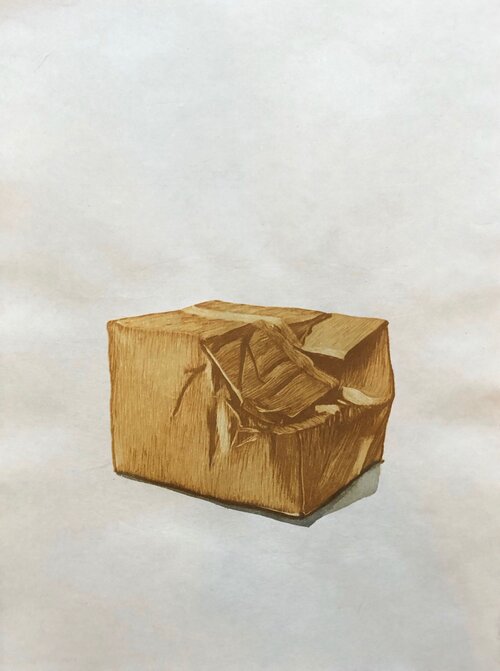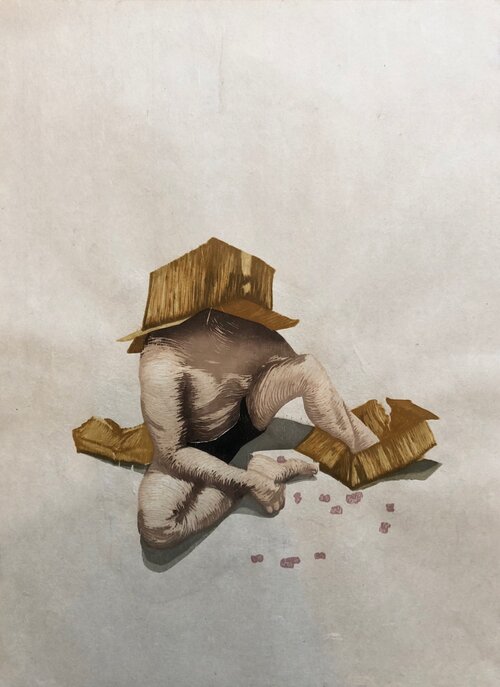Kyle Nobles
Kyle Nobles
Nobles was born in the Twin Cities in Minnesota. He received his BA in Art History and Studio Arts (emphasis in printmaking) from Hamline University in 2015, and his MFA from the University of Nebraska—Lincoln in 2018. He has shown his prints and drawings both nationally and internationally. Nobles was the recipient of the Hixson-Lied Fellowship and the Edgren Fellowship, and held a year long residency at Nebraska Innovation Studios. Nobles' work is engaged with the human experience, and the ways that identity and our sense of self shift over time. He has a background in many of the arts in addition to the visual, particularly in theatre and dance. This commitment to artistic expression of all kinds has influenced him in innumerable ways and continues to provide inspiration and enrichment in his life and work.
There’s a beautiful innocence in childhood where, although the world is large and new, it feels as though your place in it and the roles that you play are stable and unchanging. In our youth, outside of extraordinary circumstances, we are unburdened by the awareness that everything and everyone is subject to radical change—including our own sense of self. As we grow older though, looking back it becomes clear that this was never the case. In a matter of years, you can change so dramatically that you did not even notice as you became an entirely new person. For me, this realization was incredibly destabilizing. I began to feel that I no longer knew who I was, and longed for the security of the identity I had previously known. This moment of discovery and the ensuing self-reflection is the driving force behind my work. I set out to find the relationship between my past and present selves, and to acquaint myself with the person I had become. The revelation that I had changed so drastically from my prior self left me feeling fragmented and no longer comfortable in my identity. I was rootless, felt alone, and longed for the comfort of nostalgia. My drawings pull from images and memories of my childhood, and juxtapose them with images of myself in my present state. They present the struggle of integrating identities that are at odds with one another, the discomfort of confronting change from the past, and the uncertainty of the future.
In its early stages, it became clear that this work needed to be made as drawings rather than in another medium. Unlike other mediums, drawing is immediate and there is a very direct relationship between the artist and the artwork. Drawing is itself an act of discovery, one which parallels my own discovery of self. By its very nature, both technically and conceptually, this work requires time and labor which is a large part of my process. Countless hours are spent working with a piece from it conception to the final execution, and these focused tasks begin to take on meditative qualities. Through the intimate and lengthy process of recreating my image, I am symbolically pulling myself out of the ether and into being, birthing myself for a second time. As I am doing this, I am forced to pay attention to myself both as a physical subject and as a larger concept. I take into consideration each freckle, mole, fold, and crease depicting my body in as close to a non-idealized way as possible. I am not trying to flatter or denigrate myself, choosing instead to depict my form honestly and sincerely. This acknowledgement of physical imperfection echoes the acceptance of myself as a multifaceted and flawed individual. I not only have to consider my external being, but the internal as well contending with all the intricacies that build up an individual. These drawings also take into consideration the relationship that the present, in-flux self has with the more abstract and solidified past identities with which it still so longs to return to or absorb.
The work lives in a liminal space, neither fully here nor there, neither truly child or truly adult, neither completely the same or completely different. This lack of a stable identity contributes to that sense that of insecurity. This is reflected in the depiction of the figure’s attempt to rest in various containers, but never being able to fully be concealed or return to the comfort and safety of being out of sight. My body is often folded and contorted in various uncomfortable positions, seeking to fit once again into the comfort and familiarity of the past but finding that there is no going backwards. Beyond references to moments and objects from my youth, the images are pulled out of their specific time and place and meet in the vast non-descript space of the paper. The act of removing them from their context reflects the self-investigation occurring internally and allows the various signifiers of past and present selves to exist on equal footing, and receive equal consideration.
I am constructing a new identity, and placing it within the context of my past in an attempt to reconcile the perceived disparity between the two. Creating this work has been a process of self-realization, allowing me to take a serious look at who I am in the moment and find acceptance. I have come to realize that the self is not constant, and that the discomfort I have with change won’t go away. This endeavor extends beyond my personal investigation of self, operating as a case study of the effects of change on the individual as a larger construct. Like many others, I will never be done with the work of re-evaluating and recreating my self-identity. This is innately a part of the larger human condition. But, for me, finding this mindfulness is just one step on the journey to accepting that change and by extension myself.










































